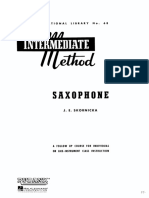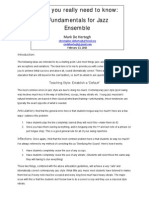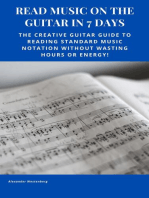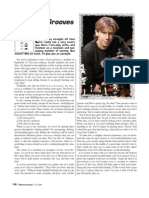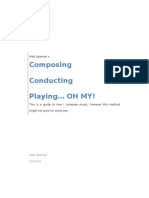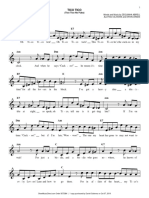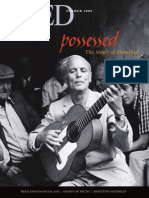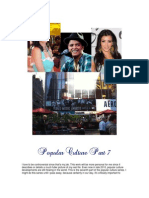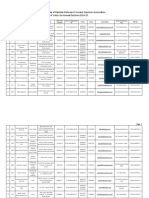Rocksax PDF
Rocksax PDF
Uploaded by
MikeysaxCopyright:
Available Formats
Rocksax PDF
Rocksax PDF
Uploaded by
MikeysaxOriginal Description:
Copyright
Available Formats
Share this document
Did you find this document useful?
Is this content inappropriate?
Copyright:
Available Formats
Rocksax PDF
Rocksax PDF
Uploaded by
MikeysaxCopyright:
Available Formats
Andrew Clark
Rock N Roll Saxophone
The Influence Of Digital Technology On Transcribing
appy New Year to all! New Year s is always the time when people are making resolutions, some more successfully than others. I sometimes use this time of year to get my students to make a simple resolution about their playing. I, myself, try to set some goals at this time of year. When I was attending Berklee in the mid 1980s, I made a resolution to learn how to transcribe. I had just inherited a Marantz tape recorder with a pitch wheel and halfspeed and I was determined to use it. I will share with you what I have learned since then about transcribing. DIGITAL TECHNOLOGY One of the most important developments in music in the past ten years has been the influence of digital technology. The introduction of the compact disc, sampling, and many other manifestations of this technology are now common place in todays music spectrum. What does this have to do with transcribing? Very simply, it means that when you turn on the radio or play a disc, you are hearing music that is in tune. This is very important to anyone wanting to learn to transcribe. When I began transcribing, compact disc players were out, but they were expensive and the discs were hard to find. When you put a record on a turntable, the pitch would not be consistent from album to album, or even turntable to turntable. This is even more noticeable with tape recorders. Im sure you all realize that there is a difference in tape speed (often times, a very dramatic difference) from one tape deck to another. This was a daunting challenge for the musicians I went to school with. My roommate was (and
Saxophone Journal
still is) a great guitar player who could play many amazing solos note for note, but he would have to re-tune drastically from song to song. This is a time consuming process. Imagine what we as saxophonists would have to do using the old limited technology. Compact discs will always play at concert pitch (A=440hz) so you know that if you hear it on your own disc player, or a radio station, or your friends disc player the music you are listening to is in tune. This is a major element in learning to transcribe, making sure that you are in tune with the song you are trying to play with. I mentioned that I have a Marantz tape deck with a pitch wheel. This is how I overcame this obstacle of getting the recording to play at concert pitch. Another important feature of this tape deck is halfspeed. Half-speed plays the tape so that it sounds an octave lower and plays half as fast. This is a crucial aid for figuring out fast licks in a solo. So, now we know that the first step to transcribing is making sure the selection is playing in tune. WHAT TO TRANSCRIBE The next thing we need to consider is what to transcribe. Sometimes you may find that you are assigned a particular tune to transcribe by a teacher, or perhaps a band youre playing with gives you a tune to learn. If youve never transcribed anything from a record before, pick something thats accessible to your range as a musician. When I first began transcribing, I picked out blues solos to start with. Blues is an easier idiom to transcribe from than others (like bebop) because the song forms and note selection will
be easier to figure out. My earliest transcriptions are of Sonny Stitt, Cannonball Adderley, Charlie Parker, and others playing a 12-bar blues. TRANSCRIBING A SOLO Now, lets talk about the step-bystep process of transcribing a solo. First, you need to transcribe the song itself and not the solo. Write out the chord changes for the song you are working on. If youve never figured out the chords to a song, then definitely pick a blues tune or a one chord jam (like Shotgun by Junior Walker) so that you will have a more productive practice session. Picking a complex jazz standard at first can be very daunting and it may leave you feeling confused and frustrated. Figure out the bass lines of a song first to get the form of the song and the chords mapped out. This will give you a framework to work with when figuring out the solo. Now that you have a chord chart put together, count up how many measures of music you are going to transcribe. If its a 12-bar blues, pick how many choruses you want to figure out. If its a short solo on the bridge of a tune, count up how long it is. This framework is very important for organizing youre efforts. Now we get to the hard part, what is this person playing? Heres where the equipment youre using becomes a crucial factor. You are going to have to hear short phrases played over and over to get them in your ear and out of your horn. If you are using just a compact disc player, many of them have a loop feature that will play a short segment repeatedly. This is very useful, but it will only play at regular 57
speed. If you are using a tape recorder, at the very least, it must have cue and review. Cue and review is fast forward and rewind respectively that works when the play button is engaged, which makes a buzzing sound when its used. If you dont have this feature on your tape deck, its going to be a longer and more arduous chore to figure out licks in a solo. If you have a sampler, you can use that as well and it will also give you the option of playing the selection back at half-speed, down an octave for figuring out those faster licks. THE CHORD CHART So, youve got your chord chart written out, your playback device is set up to play this selection in small segments over and over, now what? This brings me to an important piece of advice I learned from my first college teacher at SUNY Fredonia, Dr. Laurence Wyman (no relation to exRolling Stone Bill), If you cant sing it, you cant play it. Truer words were never spoken! Take the very first lick of the solo you have chosen and listen to it over and over until you can sing along with it exactly. You dont need a beautiful voice to do this. You just need to sing the notes in tune and in rhythm. The shorter the phrases you select, the better. Then, using youre knowledge of the chords behind the solo, find these sounds on your horn. It may take a long time to get just one phrase correct at first. Be patient and you will get it. Transcribing is like anything else in life, keep at it with an organized approach and you will improve. THE FINAL STEP: WRITING OUT WHAT YOU HEAR The final step is writing out what you hear. Ive found that the most important thing to figure out first is the rhythms. Some soloists are very free with their rhythmic approach to playing and you may find that some lines are hard to fit into a specific rhythmic notation. I think you will find that 90% of what you hear can be accurately written out. To figure out the rhythms of a phrase, I sing it slowly while tapping out the tempo. I will use a simple conducting pattern to visualize the beats of the measure 58
while Im singing the phrase (for those of you who know how to conduct a 4/ 4 pattern). This is very important in writing out the phrase. Once you have the rhythms accurately written out, its very simple to fill in the appropriate notes. TO SUMMARIZE Lets summarize this transcribing approach. First, make sure you have the proper equipment to play your selection on. Next, figure out the structure of the song (chords, arrangement, number of bars or choruses, etc.), then learn to sing each phrase one at a time accurately, which is the single most important step. Finding the notes and sounds on your horn is next. Finally, you need to write it all down so that you will remember what you have figured out. I mentioned in last months column that I had played out of the Omnibook in the past (and the present and future like any other dedicated saxophonist!). Maybe you can try to pick a blues out of that book, find the actual recording of the solo, and transcribe it yourself using the book as a reference. You may find that your interpretation may differ from Jamey Aebersolds, and thats okay as long as youre sure you are playing the solo accurately along with the recording. I did a transcription of Bob Bergs solo on Mike Sterns composition Mood Swings , and while at the Berklee bookstore one day, I saw a Trent Kynaston book which had the same solo in it. I was very happy to see that 95% of what I had written out was exactly the same! So, this may be an approach that works for you as well. Learning to play by ear is just as important as learning to play by reading music. When Im on gigs with a band for the first time, the skills Ive developed by transcribing music become very important. Being able to play by ear gives me the ability to play with others on tunes Ive never heard and make it sound like Ive been rehearsing with the band for days. These are the kinds of skills that make the phone ring and the calendar fill up, if you know what I mean. So, now you can go dig into that long list of rock and roll sax tunes and find some hot licks to transcribe! I think youll find that once you get started, its like doing crossword
puzzles. You use the clues of the song form and chords to figure out what the soloist is doing. After awhile youll hear these things coming out of your playing, which is where the real satisfaction of transcribing comes from. Speaking of satisfaction, I believe it was Keith Richards who said, I always steal from the rich, musically speaking! So get out that blank music paper and get to work! I think next we should discuss stage gear. In the rock n roll world, amplification rules. If its too loud, youre too old! So, we as saxophonists must find a way to be heard and to hear ourselves amidst the crushing din of guitars, bass, and drums. Ive assembled my own little arsenal of gear to help in that struggle to be seen and heard on stage. Ill discuss mics, effects, amps, monitors, and the like, so stay tuned and keep rocking! I can be reached via e-mail at SAXATTACK@aol.com.
January/February 1996
You might also like
- Erotic Cakes Guthrie Govan TranscriptionsDocument59 pagesErotic Cakes Guthrie Govan TranscriptionsCesar Berrios Dueñas100% (4)
- Ragtimify PDFDocument51 pagesRagtimify PDFHugo Hammond86% (7)
- Joseph Edward Skornicka - Rubank Intermediate Method Saxophone PDFDocument48 pagesJoseph Edward Skornicka - Rubank Intermediate Method Saxophone PDFRonald Malbog100% (5)
- Jazz TacticsDocument5 pagesJazz TacticsLucas Rooyakkers78% (9)
- Bob Mintzer - 12 Contemporary Jazz Etudes - Bob Mintzer (BB Tenor Sax & Soprano) PDFDocument44 pagesBob Mintzer - 12 Contemporary Jazz Etudes - Bob Mintzer (BB Tenor Sax & Soprano) PDFdepfau100% (7)
- Mcdowall - Ave Maris StellaDocument3 pagesMcdowall - Ave Maris Stellariverfall0% (2)
- Erotic CakesDocument76 pagesErotic CakesFrancisco RuaNo ratings yet
- Vocal GuideDocument8 pagesVocal Guidepaciughino1974No ratings yet
- A Rhythmic Vocabulary: A Musician's Guide to Understanding and Improvising with RhythmFrom EverandA Rhythmic Vocabulary: A Musician's Guide to Understanding and Improvising with RhythmRating: 3.5 out of 5 stars3.5/5 (4)
- Real IELTS Speaking Task Model IELTS Speaking Topics and AnDocument71 pagesReal IELTS Speaking Task Model IELTS Speaking Topics and AnTuấn Đông89% (9)
- Frisell Bill An Approach To Guitar Fingering 1Document5 pagesFrisell Bill An Approach To Guitar Fingering 1Mathias K Marstrander100% (12)
- Lucas Pickford - The Art of TranscriptionDocument4 pagesLucas Pickford - The Art of TranscriptionFirstly LastlyNo ratings yet
- How To TranscribeDocument5 pagesHow To Transcribe4scribble03100% (3)
- Bass Guitar Magazine Issue 67Document2 pagesBass Guitar Magazine Issue 67oysterhouseNo ratings yet
- Arranging Solo GuitarDocument14 pagesArranging Solo GuitarDang Dang100% (5)
- Why Transcribe? Before Covering A Process For Transcribing Jazz, It IsDocument4 pagesWhy Transcribe? Before Covering A Process For Transcribing Jazz, It IsC MorzahtNo ratings yet
- Ear Training by Jamey AebersoldDocument1 pageEar Training by Jamey AebersoldLefteris GermenlisNo ratings yet
- Memorising Chords For Bass GuitarDocument3 pagesMemorising Chords For Bass GuitarKingsley Etornam Anku100% (1)
- Learning Jazz Standards The Right Way - JazzadviceDocument22 pagesLearning Jazz Standards The Right Way - JazzadvicePaoloFurioMarasso100% (4)
- Musical Phrasing For Drummers PDFDocument3 pagesMusical Phrasing For Drummers PDFmwilliams_musicNo ratings yet
- Crash Course in Mixing CloudBounce v1.0Document54 pagesCrash Course in Mixing CloudBounce v1.0Andrew Hamilton100% (2)
- Figure Out Tunes by EarDocument3 pagesFigure Out Tunes by Eareth36dicNo ratings yet
- How Did Bill Evans Make His Two Hands Sound Like A 40 Piece Orchestra When He Touched The Keys?Document12 pagesHow Did Bill Evans Make His Two Hands Sound Like A 40 Piece Orchestra When He Touched The Keys?Frederic Francois ChopinNo ratings yet
- An Incomplete Crash Course in Contemporary Music Theory: The FundamentalsFrom EverandAn Incomplete Crash Course in Contemporary Music Theory: The FundamentalsRating: 5 out of 5 stars5/5 (1)
- 5 Jazz Ear Training Tips For Hearing The Extensions of A ChordDocument9 pages5 Jazz Ear Training Tips For Hearing The Extensions of A ChordFrederic Francois ChopinNo ratings yet
- 10 Tips and Tricks For Sight Reading Music: Practice BeforehandDocument3 pages10 Tips and Tricks For Sight Reading Music: Practice Beforehandgrover_peleNo ratings yet
- Piano Chords One: A Beginner’s Guide To Simple Music Theory and Playing Chords To Any Song Quickly: Piano Authority SeriesFrom EverandPiano Chords One: A Beginner’s Guide To Simple Music Theory and Playing Chords To Any Song Quickly: Piano Authority SeriesNo ratings yet
- Gospelpiano 1Document38 pagesGospelpiano 1Harold Hanson83% (6)
- 5 Steps To Learning Any Song in Under An Hour PDFDocument35 pages5 Steps To Learning Any Song in Under An Hour PDFJose Carlos Sanabria100% (1)
- Handout 5Document5 pagesHandout 5api-285213532No ratings yet
- English Audio Panning Secrets How To Pan Different Sounds in A MixDocument10 pagesEnglish Audio Panning Secrets How To Pan Different Sounds in A MixMugniez ClaireNo ratings yet
- Erotic Cakes - The Backing TracksDocument76 pagesErotic Cakes - The Backing TracksCarlos Celis Rodriguez100% (1)
- Erotic Cakes - The Backing TracksDocument59 pagesErotic Cakes - The Backing TracksPablo Café BarreiroNo ratings yet
- How To Write A Song On The Guitar TutorialDocument34 pagesHow To Write A Song On The Guitar TutorialHelmut Herglotz0% (1)
- Radioreadyguide PDFDocument17 pagesRadioreadyguide PDFJulio C. Ortiz MesiasNo ratings yet
- World-Beat & Funk Grooves: Playing a Drumset the Easy WayFrom EverandWorld-Beat & Funk Grooves: Playing a Drumset the Easy WayRating: 4 out of 5 stars4/5 (4)
- Guthrie Govan - ApostilaDocument11 pagesGuthrie Govan - ApostilaJosé Roberto0% (1)
- A Rough Guide To Song Construction and Arrangement - Part 1Document9 pagesA Rough Guide To Song Construction and Arrangement - Part 1Paulo Hardt100% (2)
- Effective RehearsalsDocument6 pagesEffective RehearsalsHamilton DurantNo ratings yet
- SlowerThanDirt TunebookDocument28 pagesSlowerThanDirt Tunebookguitar90909090No ratings yet
- Chord Embellishments The Progr - Don LatarskiDocument88 pagesChord Embellishments The Progr - Don LatarskiGuy VNo ratings yet
- Jazz Reading EleDocument14 pagesJazz Reading EleQuốc Liêm100% (8)
- 5 Effective Ways To Learn Jazz StandardsDocument4 pages5 Effective Ways To Learn Jazz StandardsÓscarNo ratings yet
- InThePocket EssentialGrooves 1Document3 pagesInThePocket EssentialGrooves 1giannis79No ratings yet
- How To Remix Music Genres: A Remix Philosophy and Remix Music Genre GuideFrom EverandHow To Remix Music Genres: A Remix Philosophy and Remix Music Genre GuideRating: 3 out of 5 stars3/5 (2)
- Gospelpiano 2Document40 pagesGospelpiano 2Harold Hanson100% (1)
- Bass Crash CourseDocument24 pagesBass Crash Courselouminn100% (3)
- Orchestration For DummiesDocument4 pagesOrchestration For Dummiesskullandbones50% (2)
- Journal On The Art of Record Production Interview With Kevin DoyleDocument11 pagesJournal On The Art of Record Production Interview With Kevin DoyleDavid RadcliffeNo ratings yet
- Null 5 PDFDocument51 pagesNull 5 PDFphilip kanzaNo ratings yet
- Steve Fidyk Learning Developing On Drum SetDocument3 pagesSteve Fidyk Learning Developing On Drum SetCardician70% (1)
- Art of Playing by EarDocument28 pagesArt of Playing by Earqt060701278882% (11)
- Pentatonic ScaleDocument5 pagesPentatonic ScaleHamilton GrimaldiNo ratings yet
- 59.playing by EarDocument4 pages59.playing by EarRendy Vivo100% (1)
- Jazz Piano Fundamentals (Book 2): Exercises, Explanations, Listening Guides and Practice PlansFrom EverandJazz Piano Fundamentals (Book 2): Exercises, Explanations, Listening Guides and Practice PlansNo ratings yet
- Composing Guide 2003Document10 pagesComposing Guide 2003Matt Allen SpencerNo ratings yet
- Piano Chords Three: Numbers - How to Play Songs By Ear Without Sheet Music Using The Nashville Number System: Piano Authority Series, #3From EverandPiano Chords Three: Numbers - How to Play Songs By Ear Without Sheet Music Using The Nashville Number System: Piano Authority Series, #3Rating: 5 out of 5 stars5/5 (1)
- Winslow Lig SizesDocument1 pageWinslow Lig SizesMikeysaxNo ratings yet
- Creston MasterclassDocument3 pagesCreston MasterclassMikeysaxNo ratings yet
- Joe Allard Basic PrinciplesDocument11 pagesJoe Allard Basic PrinciplesJasmine KlineNo ratings yet
- Altissimo DemystifiedDocument7 pagesAltissimo DemystifiedMikeysax100% (2)
- Joe Allard Basic PrinciplesDocument11 pagesJoe Allard Basic PrinciplesJasmine KlineNo ratings yet
- SilveradoDocument3 pagesSilveradoMikeysaxNo ratings yet
- Moments Notice Brecker SoloDocument3 pagesMoments Notice Brecker SoloMikeysax100% (2)
- 0english TensesDocument8 pages0english TensesMirela MarinNo ratings yet
- 60-80s Pop Culture ProjectDocument3 pages60-80s Pop Culture Projectapi-294925785No ratings yet
- Tico Tico: (Tico Tico No Fuba)Document2 pagesTico Tico: (Tico Tico No Fuba)Dani100% (2)
- Reed 08-2009Document7 pagesReed 08-2009Marija BartulovicNo ratings yet
- Har Mar Superstar - Prisoner Chords PDFDocument2 pagesHar Mar Superstar - Prisoner Chords PDFEmilio TapiaNo ratings yet
- Grade 9 English FinalDocument25 pagesGrade 9 English FinalJeanifer Hadjula Lisbo Galleron100% (1)
- Practice Test 4 (2021) : phần nghe có tín hiệuDocument14 pagesPractice Test 4 (2021) : phần nghe có tín hiệuNguyễn Hải ĐăngNo ratings yet
- Logic1 Notes Logic1notes Chapter 1Document43 pagesLogic1 Notes Logic1notes Chapter 1helloron2309No ratings yet
- Roland Ep 97Document15 pagesRoland Ep 97sender2000No ratings yet
- P.E and Health 3 ModuleDocument81 pagesP.E and Health 3 ModuleMartha Grace GrengiaNo ratings yet
- Popular Culture Galore Part 7Document79 pagesPopular Culture Galore Part 7Timothy100% (1)
- Resume SanigaDocument2 pagesResume Sanigaapi-203008402No ratings yet
- Liszt: Collected Works For Piano: DISK 2: Transcriptions, Paraphrases, ConcertosDocument5 pagesLiszt: Collected Works For Piano: DISK 2: Transcriptions, Paraphrases, Concertos7h52gpd9ndNo ratings yet
- SportReport Ebook 13-22-23Document32 pagesSportReport Ebook 13-22-23Jochen SchachNo ratings yet
- Karachi Head Office Membership List PDFDocument10 pagesKarachi Head Office Membership List PDFEngr Hamid Ali100% (1)
- Morphing Techniques For Enhanced Scat SingingDocument4 pagesMorphing Techniques For Enhanced Scat SingingMilton Villarroel G.100% (1)
- Recovering The US Hispanic Literary Heritage, Vol III Edited by Maria Herrera-SobekDocument465 pagesRecovering The US Hispanic Literary Heritage, Vol III Edited by Maria Herrera-SobekArte Público PressNo ratings yet
- Guitar Syllabus 2016-19 (Online Edition)Document66 pagesGuitar Syllabus 2016-19 (Online Edition)niraj_hwb0% (2)
- Abide With MeDocument6 pagesAbide With MeLamthanhvanNo ratings yet
- Animal Crossing - The Roost (Piano Cover) Sheet Music For Piano (Solo)Document1 pageAnimal Crossing - The Roost (Piano Cover) Sheet Music For Piano (Solo)KorelisNo ratings yet
- 2nd Cond - English 4Document8 pages2nd Cond - English 4kenny.vazquezNo ratings yet
- SDC 2021 Calendar v15Document1 pageSDC 2021 Calendar v15jandujar26No ratings yet
- Soal B.ingg Psaj Xii 2024Document20 pagesSoal B.ingg Psaj Xii 2024Ria SiregarNo ratings yet
- Creativity and Mental Illness Richard Kogan and RachmaninoffDocument4 pagesCreativity and Mental Illness Richard Kogan and RachmaninoffAna Maria RomeroNo ratings yet
- Blue in Green PaperDocument3 pagesBlue in Green PaperEthanNo ratings yet
- Kartik HandbookDocument56 pagesKartik HandbookavatunaNo ratings yet


